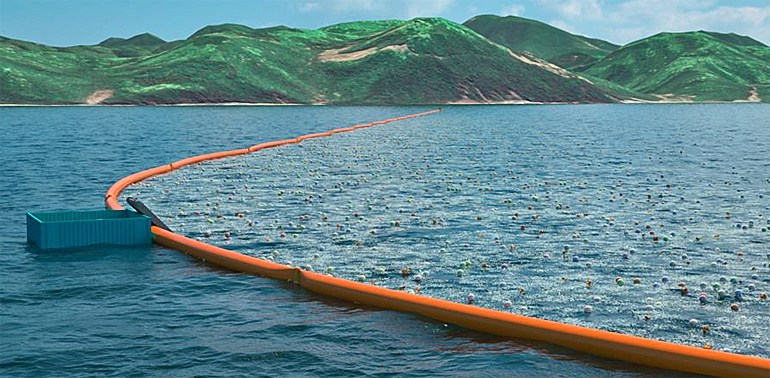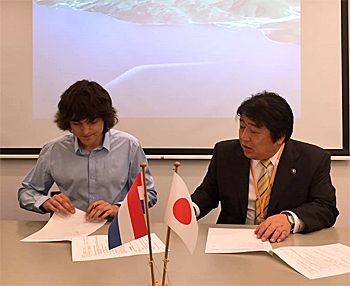Ocean Cleanup announces world's first floatable ocean cleanup installation near Tsushima island, Japan
 Founder and CEO Boyan Slat of Ocean Cleanup signed an agreement with the mayor of the Japanese island Tsushima about the deployment of its first floatable installation to remove plastic waste from the sea.
Founder and CEO Boyan Slat of Ocean Cleanup signed an agreement with the mayor of the Japanese island Tsushima about the deployment of its first floatable installation to remove plastic waste from the sea.
The island Tsushma is situated halfway between Korea and Japan. Every year 30,000 cubic meters of trash is deposited on its shores. The collection of this garbage costs about 5 million USD annually. The pilot array from Ocean Cleanup will be catching trash before it reaches the shoreline, potentially saving costs.
The feasibility is currently being researched and Boyan Slat expects its first installation to be operational in the second quarter of 2016.
 Boyan Slat and Tsushima Island’s mayor Yasunari Takarabe sign agreement for the coastal pilot on 20 May.
Boyan Slat and Tsushima Island’s mayor Yasunari Takarabe sign agreement for the coastal pilot on 20 May.
Longest floating structure ever
The installation consists of a boom and platform (see above impression). The boom will span 2000 meters, thereby becoming the longest floating structure ever deployed in the ocean. This beats the current record of 1000 m held by the Tokyo Mega-Float, a 1000 metre floating runway in Tokyo Bay.
The pilot installation will be operational for at least two years, catching plastic pollution before it reaches the shores of the proposed deployment location of Tsushima island.
Tsushima island is evaluating whether the plastic can be used as an alternative energy source.
Important milestone
The deployment represents an important milestone in The Ocean Cleanup’s mission to remove plastic pollution from the world’s oceans. Within five years, after a series of deployments of increasing scale, The Ocean Cleanup plans to deploy a 100km-long system to clean up about half the Great Pacific Garbage Patch, between Hawaii and California.
Boyan Slat, 20 year-old founder and CEO of The Ocean Cleanup: "Taking care of the world’s ocean garbage problem is one of the largest environmental challenges mankind faces today. Not only will this first cleanup array contribute to cleaner waters and coasts but it simultaneously is an essential step towards our goal of cleaning up the Great Pacific Garbage Patch. This deployment will enable us to study the system’s efficiency and durability over time."
This news item was originally published on the website of Ocean Cleanup.
Read also on this website
● Dutch inventor Boyan Slat wins UN top award for Ocean clean-up initiative, 18 November 2014
● Crowdfunding reached goal: 2 million dollars for prototype to clean oceans from plastics, 11 September 2014
More information
The Ocean Cleanup
Delft, the Netherlands
www.theoceancleanup.com



